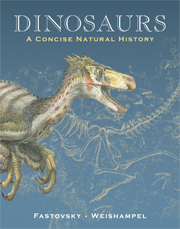Book contents
- Frontmatter
- Contents
- Why a natural history of dinosaurs?
- Dedication
- Part I Reaching back in time
- Part II Ornithischia: armored, horned, and duck-billed dinosaurs
- Part III Saurischia: meat, might, and magnitude
- Part IV Endothermy, endemism, and extinction
- Glossary
- Figure credits
- Index of subjects
- Index of genera
Part II - Ornithischia: armored, horned, and duck-billed dinosaurs
- Frontmatter
- Contents
- Why a natural history of dinosaurs?
- Dedication
- Part I Reaching back in time
- Part II Ornithischia: armored, horned, and duck-billed dinosaurs
- Part III Saurischia: meat, might, and magnitude
- Part IV Endothermy, endemism, and extinction
- Glossary
- Figure credits
- Index of subjects
- Index of genera
Summary
In the preceding chapter we met Ornithischia, one of the two great branches of dinosaurs. Although it was identified as early as 1887, nobody at that time had an inkling how diverse the group really was. Since then, we have learned about the richness of ornithischians as well as about the anatomy, evolution, and even behavior of these dinosaurs. We'll check out ornithischians in Chapters 5–7. But first, let's introduce Ornithischia a bit more completely.
What makes an ornithischian an ornithischian?
Diagnostic features for Ornithischia abound. Among these, two stand out:
In all ornithischians, at least a part of the pubis has rotated backward to lie close to and parallel with the ischium; this orientation is called opisthopubic (Figure II.1).
All ornithischians had a unique bone, the predentary, an unpaired, scoop-shaped element that capped the front of the lower jaws (Figure II.2).
Both of these adaptations were associated with food consumption and processing. The evolution of the rearward-directed pubis (recall that, primitively, the pubis points forward; see Figure 4.5) is believed to be associated with the development of a large stomach (or stomachs) and intestinal region (gut), the better for extracting nutrients from plants. Accommodating the large gut was a barrel-shaped torso, recognizable from the shape of the ribs. The predentary supported the lower portion of a beak, a characteristic feature of all ornithischians (see below).
- Type
- Chapter
- Information
- DinosaursA Concise Natural History, pp. 74 - 83Publisher: Cambridge University PressPrint publication year: 2009

